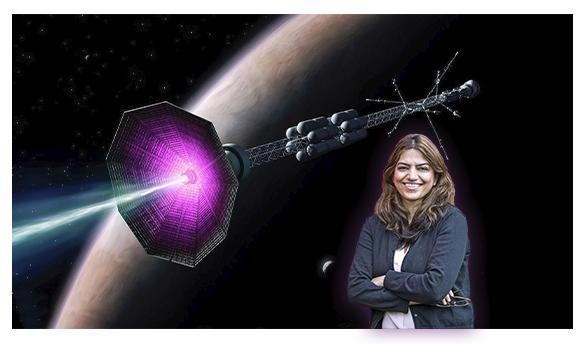Jan 28 2021
A physicist from the Princeton Plasma Physics Laboratory (PPPL) of the U.S. Department of Energy (DOE) has proposed a new kind of rocket thruster that could take mankind to Mars and beyond.
 PPPL physicist Fatima Ebrahimi in front of an artist's conception of a fusion rocket. Image Credit: Elle Starkman, Princeton Plasma Physics Laboratory Office of Communciations, and ITER.
PPPL physicist Fatima Ebrahimi in front of an artist's conception of a fusion rocket. Image Credit: Elle Starkman, Princeton Plasma Physics Laboratory Office of Communciations, and ITER.
By applying magnetic fields, the rocket thruster would cause plasma particles to expel from the rear side of a rocket and, since momentum is conserved, it would push the rocket forward. Plasma is an electrically charged gas, also called the fourth state of matter. Electric fields are used by existing space-proven plasma thrusters to push the particles.
The novel idea would speed up the particles through magnetic reconnection—a process that can be seen across the universe, such as the surface of the Sun, where magnetic field lines meet together, then abruptly separate, and subsequently re-join together, creating plenty of energy. Moreover, reconnection takes place within the doughnut-shaped fusion devices, called tokamaks.
“I’ve been cooking this concept for a while,” stated Fatima Ebrahimi, Principal Research Physicist at PPPL, the concept’s inventor, and the author of the article explaining the concept in the Journal of Plasma Physics.
She added, “I had the idea in 2017 while sitting on a deck and thinking about the similarities between a car’s exhaust and the high-velocity exhaust particles created by PPPL’s National Spherical Torus Experiment (NSTX),” the frontrunner of the current flagship fusion facility of the laboratory.
During its operation, this tokamak produces magnetic bubbles called plasmoids that move at around 20 kilometers per second, which seemed to be a lot like thrust.
Fatima Ebrahimi, Study Author and Principal Research Physicist, Princeton Plasma Physics Laboratory
Fusion is a power that fuels all the stars, including the Sun. In fusion, light elements are combined in the form of plasma—the hot and charged state of matter made up of atomic nuclei and free electrons that represent 99% of the perceptible universe—to create large quantities of energy. Investigators are looking for ways to simulate fusion on Earth for an almost infinite supply of power to produce electricity.
Existing plasma thrusters that utilize electric fields to accelerate the particles can only create a low specific speed, or impulse.
However, computer simulations conducted on PPPL computers and the National Energy Research Scientific Computing Center demonstrated that the novel concept of plasma thruster can create exhaust with velocities of hundreds of kilometers for each second, that is, 10-fold faster than those of other forms of thrusters.
The National Energy Research Scientific Computing Center is a DOE Office of Science User Facility at Lawrence Berkeley National Laboratory in Berkeley in California.
That faster velocity at the start of the journey of a spacecraft could bring the exterior planets within the reach of astronauts,
Long-distance travel takes months or years because the specific impulse of chemical rocket engines is very low, so the craft takes a while to get up to speed,” she said. “But if we make thrusters based on magnetic reconnection, then we could conceivably complete long-distance missions in a shorter period of time.
Fatima Ebrahimi, Study Author and Principal Research Physicist, Princeton Plasma Physics Laboratory
Three major differences exist between Ebrahimi’s plasma thruster concept and other devices. The first difference is that altering the strength of the magnetic fields can either decrease or increase the amount of thrust.
“By using more electromagnets and more magnetic fields, you can in effect turn a knob to fine-tune the velocity,” added Ebrahimi.
The second difference is that the novel thruster creates movement by expelling plasma particles as well as magnetic bubbles called plasmoids. The plasmoids add more power to the propulsion but these are not incorporated by other thruster concepts.
The third difference is that unlike existing thruster concepts that tend to depend on electric fields, the magnetic fields in Ebrahimi’s new concept enable the plasma within the thruster to contain either light or heavy atoms. Such flexibility allows investigators to customize the amount of thrust for a specific mission.
While other thrusters require heavy gas, made of atoms like xenon, in this concept you can use any type of gas you want.
Fatima Ebrahimi, Study Author and Principal Research Physicist, Princeton Plasma Physics Laboratory
In a few cases, researchers may prefer light gas because the smaller atoms can start shifting more rapidly.
A concept like this extends the range of space propulsion research of PPPL. Other studies comprise the Hall Thruster Experiment which was commenced back in 1999 by PPPL physicists Yevgeny Raitses and Nathaniel Fisch to explore the application of plasma particles for moving spacecraft.
Along with his students, Raitses is also studying the use of very small Hall thrusters to give small satellites, known as CubeSats, more maneuverability as they revolve around the Earth.
Ebrahimi further emphasized that her new thruster concept directly stems from her studies into fusion energy.
“This work was inspired by past fusion work and this is the first time that plasmoids and reconnection have been proposed for space propulsion. The next step is building a prototype!,” Ebrahimi concluded.
The study was supported by the DOE Office of Science (Fusion Energy Sciences) and Laboratory Directed Research and Development (LDRD) funds made available via the Office of Science.
Journal Reference:
Ebrahimi, F (2020) An Alfvenic reconnecting plasmoid thruster. Journal of Plasma Physics. doi.org/10.1017/S0022377820001476.